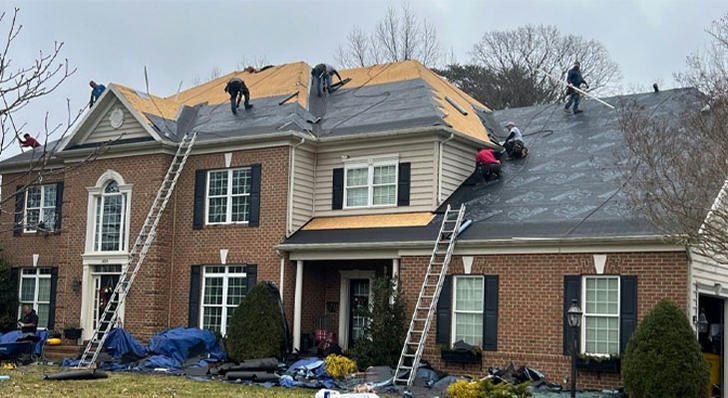How To Get A Government Grant For Roof Replacement In The United States
Replacing your roof can be a significant expense, especially for homeowners on a tight budget. Fortunately, a variety of government grants and assistance programs in the United States can help ease the financial burden. This article will explore the different grants available to homeowners, outline the process for applying for these grants, and provide case studies to illustrate how these programs work.

I.Different Government Grants Can Help Pay for Roof Replacement
1.Weatherization Assistance Program (WAP)
The Weatherization Assistance Program (WAP) is a federal program designed to help low-income households reduce their energy costs by improving the energy efficiency of their homes. While WAP focuses primarily on insulating homes, it can also cover the cost of roof repairs and replacements if the home's overall energy efficiency needs to be improved. If your roof is in poor condition and is causing heat loss or other energy inefficiencies, WAP may cover the cost of replacing your roof.
2.USDA Rural Repair and Renewal Grants
The United States Department of Agriculture (USDA) offers grants and loans through its Rural Repair and Renewal Program designed to help low-income homeowners in rural areas. This grant can be used to repair or replace a roof, and is a valuable resource for rural homeowners who can't afford it.
3.HUD Community Development Block Grants (CDBG)
The Department of Housing and Urban Development (HUD) offers Block Grants (CDBG) to provide local governments with funding for a variety of community improvement projects, including home rehabilitation. Roof replacement falls into this category. However, the availability of these grants depends on local priorities, so they may not always be available to every homeowner.
4.State and Local Housing Programs
Many state and local governments also offer their own home rehabilitation programs to help cover the cost of roof replacement. These programs may be funded by the federal government or may be state initiatives. In some cases, these programs are designed to help seniors, veterans, or low-income families make necessary home repairs.
II.How to Apply for a Government Grant (8 Steps)
Step 1:Determine Your Eligibility
Before applying for any grant, review the eligibility requirements. Factors such as income, location, and roof condition will determine which programs you qualify for.
tep 2:Gather Documents
Most grant programs require detailed documentation, including proof of income, home ownership, and, in some cases, proof of the condition of your roof. Be sure to have your tax returns, mortgage documents, and any relevant repair estimates ready.
Step 3:Research Available Programs
Research possible grant programs you may qualify for, including federal, state, and local grant programs. Contact your local housing authority or government office for more information.
Step 4:Contact Local Agencies
For programs like WAP and CDBG, you will need to contact your local agency or housing authority. These agencies can provide you with more details about the application process and assist you in submitting the required forms.
Step 5:Complete the Application
Once you have identified the right program and have gathered your documents, complete the grant application. Double-check that all information is accurate to avoid delays.
Step 6:Submit the Application
Submit your application by the required deadline and keep copies of all documents. Some applications can be submitted online, while others must be mailed or submitted in person.
Step 7:Follow-up
After submitting your application, it’s a good idea to follow up with the agency or organization to confirm that they received your application and to ask about the approval timeline.
Step 8: Funding Approval and Use
If your grant application is approved, you will receive the funds or services you need to replace your roof. Be sure to follow any guidelines provided by the grant program on how to use the funds.
III.Case
The Smith family lives in rural Kentucky and owns a modest house. After several severe storms, their roof was in urgent need of replacement. But with limited income, they couldn’t afford the high cost of repairs.
After researching their options, the Smiths applied for the USDA Rural Restoration and Reconstruction Grant. They met the program’s income requirements, and because their home was located in an eligible rural area, they qualified for a $7,500 grant.
The Smiths gathered the necessary documentation, including proof of income and a contractor’s estimate. After submitting their application, they followed up with the USDA to confirm progress. Two months later, their application was approved and the grant covered the full cost of replacing their roof.
IV.Conclusion
Replacing your roof can be an expensive and stressful experience, but government grants and assistance programs can provide much-needed financial relief. Programs such as the Weatherization Assistance Program, USDA Rural Repair and Reconstruction Grants, HUD CDBG, and state or local housing programs all offer eligible homeowners ways to obtain the funds they need to replace their roof.
By understanding the application process and knowing where to find these resources, homeowners can successfully obtain grants to help pay for roof replacement. If you are facing an expensive roof repair, consider exploring these options to see if you qualify for assistance.
